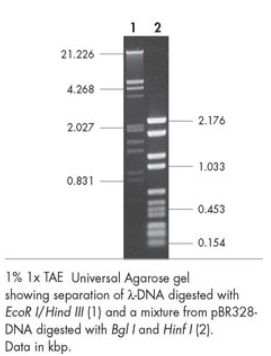Agarose for perfect results in gel electrophoresis
Agarose for electrophoresis in electrophorese gel has an excellent price. Standard Agarose is ideal for use for analytical as well as preparative DNA electrophoresis of DNA fragments from 50 bp to 50 kbp.
Agarose for the separation of nucleic acid in gel-electrophoresis
Universal Agarose for gel electrophoresis and an excellent price is ideal for analytical as well as preparative nucleic acid electrophoresis of fragments from 50 bp to 50 kbp. Even at low concentrations the gel produced is very firm.
Agarose Productsizes:
604-001 - 100 g
604-005 - 500 g
604-005-2 - 2x 500 g
604-005-5 - 5x 500 g
604-005-10 - 10x 500 g
Final price excl. shipping costs3
- verfügbar / avaílable
- 1 - 3 days for delivery / 1 - 3 Tage Lieferzeit1

Features Agarose for gel:
- High separation properties and sharp band patterns
- Easy solubility without foaming
- Excellent optical transparency
Applications for gel:
- Separation of PCR products
- DNA: approx. 0.05 kbp – 50 kbp
- RNA: approx. 0.30 kb – 20 kb
SpecificationsAgarose in gels:
- Gelling temperature: ≤ 37 °C
- Melting temperature: ≤ 90 °C
- Electroendosmosis: ≤ 0.140
- Gel strength (1.5 %): ≥ 2300 g / cm2
- Sulphate content: ≤ 0.10 %
- Water content: ≤ 10.0 %
Agarose Stability tests / Quality Tests
Quality Assurance:
'Molecular Biology Grade' for Gel electrophoresis
- Certified free of DNases and RNases
- No DNA binding
- High lot-to-lot consistency
Quality control of Agarose for electrophoresis
'Molecular Biology Grade'
- Certified free of DNases and RNases - best for gel
- No DNA binding
- High lot-to-lot consistency
Even at low concentrations the agarose gel produced is very firm
Taqs:
Agar, electrophorese, gele, Nukleinsäure, Gel Elektrophorese, agarose gel, Ethidiumbromid, puffer, gele für nukleinsäure auf agarosegel
Agarose usage protocol
Method 1: Agarose for electrophoresis in Microwave oven
1. Pour puffer (approx. 90 % of final volume) into an appropriate flask that can accommodate up to four times the final gel volume and add a magnetic stir bar.
2. Put the flask of puffer with agarose onto a magnetic stirrer and slowly add agarose powder while stirring constantly to avoid clotting.
3. Remove flask magnetic stir bar.
4. Add remaining buffer up to the desired final volume.
5. Weigh and record the weight of of agarose and all components the flask prior to heating. Heat for 1 – 2 minutes in a microwave oven (600 Watt). Gently swirl the flask to mix the solution.
Warning: Due to microwave heating of puffer, there may be a delay in the liquid boiling!
6. Using the microwave oven, heat in short bursts of 5 – 10 seconds or until the solution with agarose is boiling, with breaks of 10 – 15 seconds between heating phases to disperse bubbles by
gently swirling the flask. Beware of hot glass ware and liquid. Continue until the agarose is completely dissolved.
7. Again, weigh the flask and top up lost volume with warm, deionized water. Gently swirl the flask to ensure complete mixing of agarose and all components.
8. Let the solution cool down at room temperature for 15 – 20 minutes or until a gel temperature of 50 – 60 °C is reached.
Method 2: Simmering water bath
1. see method 1 (agarose in micro wave oven): steps 1 – 2 and 4
2. Weigh and record the weight of the flask prior to heating. Heat agarose suspension up in a simmering water bath with constant stirring.
3. Leave the flask of agarose and all components bath in the water for further 15 – 20 minutes, or until the agarose is completely dissolved.
4. Switch off the magnetic stirrer and leave the flask with agarose in the bath for further 15 minutes.
5. Again, weigh the flask and top up lost volume with warm, deionized water. Gently swirl the flask to ensure complete mixing of agarose and all components.
6. Let the solution of agarose cool down at room temperature for 15 – 20 minutes or until a gel temperature of 50 – 60 °C is reached.
Storage: Agarose can be stored at room temperature for more than 4 years
Agarose free sample request
Dear customer, GeneON likes to send free samples for Agarose for Gelelektrophorese to convince the valued customer about the quality. Please understand that the shipping costs may be very high to some destinations. That is the reason why we cannot assure to fulfil all sample requests. Sorry for that, please understand. You may also set an inquiry/order directly by e-mail . (DNA)
Deutsche Beschreibung
Related products
Datasheet Agarose
Material Safety Datasheet
Agarose: References / Protocols / Notes / Recomendations / Tests





